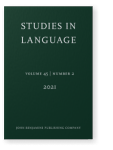Vol. 45:2 (2021) ► pp.428–469
Additive particle uses in Hungarian
A Role and Reference Grammar account
In this paper, we investigate empirical data that raise challenging issues with respect to focus sensitivity of the Hungarian additive particle is ‘also, too’. In Hungarian, the additive particle is attached to a constituent, and the is-phrase cannot occupy the structural focus position. This raises the issue how to capture the focus sensitivity of is. We propose a primarily pragmatic, context-based analysis of the Hungarian additive particle, where the particle associates with the pragmatic focus (Lambrecht 1994) determined on basis of the immediate question under discussion (Roberts 2012). Important evidence for this claim is that the Hungarian additive particle can take different semantic associates, corresponding to the pragmatic focus of the sentence. After discussing the Hungarian data, we will present the analysis in the framework of Role and Reference Grammar (Van Valin & LaPolla 1997; Van Valin 2005). To capture Hungarian and English data in a uniform way, important extensions of the framework will be proposed.
Article outline
- 1.Introduction
- 1.1Additive particles and focus sensitivity
- 1.2A short note on Hungarian sentence structure
- 2.The Hungarian additive particle is
- 2.1Syntactic host and semantic associate
- 2.2Different semantic associates
- 3.A context-based analysis
- 3.1Pragmatic focus and local discourse context
- 3.1.1Sentential semantic associate
- 3.1.2Predicate associate
- 3.1.3Narrow semantic associate
- 3.1.4Interim summary
- 3.2Further aspects
- 3.2.1Prosody
- 3.2.2Various uses and structural distribution
- 3.2.3Postverbal occurrences
- 3.1Pragmatic focus and local discourse context
- 4.Implementation in Role and Reference Grammar
- 4.1RRG: Basic architecture
- 4.2RRG: the focus projection
- 5.Analysis: Additive particles in RRG
- 5.1English additive particles
- 5.2Hungarian additive particles
- 6.Summary
- Acknowledgements
- Notes
- Abbreviations
-
References
